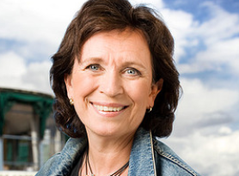Can Nordic refugee policies be coordinated?
The large number of refugees arriving in the Nordic countries is having consequences for Nordic cooperation. This is the theme for the Nordic Council’s session in Oslo. New border obstacles have emerged, and if the refugee situation is handled very differently in the different Nordic countries it could have grave consequences.
 “The aim must be to normalise the situation and to remove borders obstacles when the situation comes back under control,” says Bente Stein Mathisen. She chairs the welfare committee at the Nordic Council and is an MP from Norway’s Conservative Party.
“The aim must be to normalise the situation and to remove borders obstacles when the situation comes back under control,” says Bente Stein Mathisen. She chairs the welfare committee at the Nordic Council and is an MP from Norway’s Conservative Party.
It has been just over three months since border controls were introduced, after the flow of refugees peaked towards the end of 2015. Sweden’s decision on 4 January 2016 to introduce border controls for people arriving from Denmark was historic. Nordic citizens travelling between Denmark and Sweden had not needed to show ID since the Nordic Passport Union came into force in 1954. Border controls were also introduced on the Danish border with Germany, and Finland introduced visa requirements to passengers on ferries from Germany. Norway increased its internal border controls.
Large social losses
According to a new report from the Chamber of Commerce and Industry of Southern Sweden, the border controls meant annual social losses of 1.5 billion Swedish kronor (€163m). The Chamber of Commerce believes this will be the cost when commuters are delayed and the Øresund Region’s market potential falls, while others believe the effect will be less severe.
Although these figures pale in comparison with the total cost facing each country as a result of the refugee situation, which of course is much higher, the Nordic ministers for cooperation worry about what these border controls signify for Nordic cooperation as a whole.
Finland’s Minister of Transport Anne Berner, who is also minister for cooperation while Finland holds the Nordic Council of Ministers presidency, has said that border obstacles are damaging to Nordic cooperation. She is the first speaker during the Oslo session. Meanwhile, the Danish Conservative People’s Party will propose further border controls for people travelling from Sweden to Denmark.
The party’s arguments are based on information that Sweden houses 40,000 unregistered refugees, has radical areas like Rosengård in Malmö – and one Swedish suspected terrorist.
“Introducing border controls was one step back for Nordic cooperation. At the same time we faced an extreme situation last year with all the refugees flowing in from Europe. It was necessary to tighten up and regain control over the situation. That is why border controls became a necessary measure,” says Bente Stein Mathisen.
Mixed with the EU’s agreement with Turkey in March, which means refugees leaving from there to Greece will be sent back to Turkey, the border controls have had a dramatic effect on the flow of refugee to the Nordic region.
In October and November 2015 the Nordic region saw a total of 114,435 asylum applications. In January and February the figure had fallen to less than ten percent of that; 10,905 asylum applications. The question now is whether the flow of refugees has been permanently dampened, or whether new, large flows will come later this year. Libya is one of the new countries people are now fleeing. In just two days, on 11 and 12 April, the Italian coast guard rescued 4,000 refugees in the waters between Libya and Sicilia.
A great challenge
“The consequences for Nordic cooperation could become challenging and difficult in the long run if different Nordic countries handle the refugee situation very differently,” says Bente Stein Mathisen.
“Norway and Denmark have had stricter refugee policies than Sweden. Only people needing protection according to the refugee convention’s rules are granted residency. Refugees who flee in order to create a better economic future for themselves and their families are not granted permission to stay.
“When Sweden accepts so many more, open borders become a challenge because all of the refugees accepted by Sweden can then move on to the other Nordic countries. That is why it is more important than ever that the Nordic countries cooperate, agree, share experiences and help each other to handle the situation we find ourselves in,” says Bente Stein Mathisen.
“These are issues which we will be debating when the Nordic Council meet in the Norwegian parliament on 19 April. How do we normalise the situation? And what are the problems which border controls have led to?”
Danish railways DSB have lost 30 million Danish kroner (€4m) as a result of ID controls, according to an analysis from the Øresund Institute. One in five commuters have chosen not to travel by train. Photo: René Strandbygaard, DSB
 Follow us on Facebook
Follow us on Facebook
